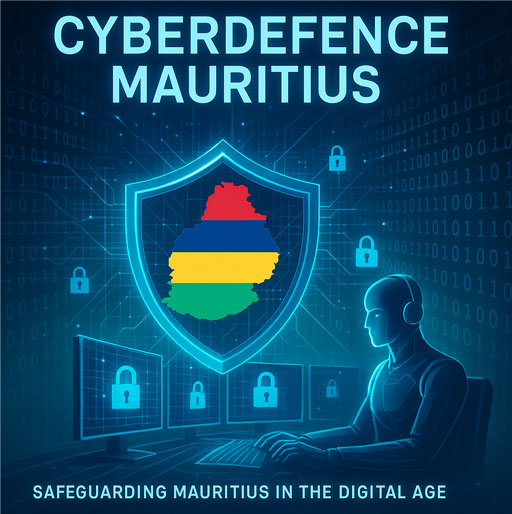Protecting the digital soul of my beloved country, Mauritius.❤️
In an era where the internet underpins nearly every facet of modern life, from communication to commerce, the importance of robust cyberdefence cannot be overstated. Cyberthreats—ranging from phishing scams to sophisticated state-sponsored attacks—pose significant risks to individuals, businesses, and national security. Simultaneously, law enforcement agencies, such as Police IT Units, rely on advanced technological support to combat cybercrime and recover critical data. This article explores strategies for enhancing online user protection, outlines methods to assist Police IT Units in data recovery, and celebrates the passion for fostering a secure digital infrastructure that empowers youth and preserves a nation’s digital soul.
Strengthening Cyberdefence: Protecting Users Online
The internet is a double-edged sword, offering unparalleled connectivity while exposing users to a myriad of threats. To better protect users online, a multi-layered approach to cyberdefence is essential, combining technology, education, and policy.
1. Enhancing User Education and Awareness
The first line of defence is an informed user base. Many cyberattacks, such as phishing or social engineering, exploit human error. Comprehensive cybersecurity education campaigns can empower users to recognize and mitigate risks. Key initiatives include:
- Phishing Awareness Training: Teach users to identify suspicious emails, links, and attachments. Simulated phishing exercises can reinforce learning.
- Password Hygiene: Promote the use of strong, unique passwords managed through reputable password managers. Encourage multi-factor authentication (MFA) wherever possible.
- Safe Browsing Habits: Educate users on avoiding unsecured websites, using VPNs on public Wi-Fi, and keeping software updated to patch vulnerabilities.
Governments and organizations should partner with schools, workplaces, and community centers to deliver accessible cybersecurity workshops, ensuring inclusivity across age groups and socioeconomic backgrounds.
2. Deploying Advanced Technological Safeguards
Technology plays a critical role in fortifying online defences. Key solutions include:
- Endpoint Protection: Deploy advanced antivirus and anti-malware software with real-time threat detection. Machine learning algorithms can identify and neutralize zero-day threats.
- Network Security: Implement firewalls, intrusion detection systems (IDS), and secure DNS protocols to filter malicious traffic. Zero-trust architecture, which verifies every user and device, minimizes unauthorized access.
- Encryption: Encourage end-to-end encryption for communications and data storage. Tools like TLS for websites and encrypted messaging apps (e.g., Signal) protect sensitive information.
- AI-Driven Threat Intelligence: Leverage artificial intelligence to analyze vast datasets, predict attack patterns, and respond to threats proactively.
Organizations must also adopt regular penetration testing and vulnerability assessments to identify weaknesses before attackers exploit them.
3. Strengthening Policy and Collaboration
Effective cyberdefence requires robust policies and global cooperation. Governments should:
- Enforce Data Protection Laws: Regulations like GDPR or CCPA set standards for data privacy, compelling organizations to prioritize user security.
- Foster Public-Private Partnerships: Collaborate with tech companies to share threat intelligence and develop unified standards for cybersecurity.
- Combat Cybercrime Internationally: Support treaties like the Budapest Convention to streamline cross-border investigations and prosecutions.
By aligning technology, education, and policy, we can create a safer online environment where users can navigate with confidence.
Supporting Police IT Units: Data Recovery and Cyberforensics
Police IT Units play a pivotal role in combating cybercrime, from investigating fraud to recovering evidence in criminal cases. Supporting these units, particularly in data recovery from seemingly irretrievable sources like permanently formatted hard disks, requires specialized expertise and tools.
1. Data Recovery from Formatted Hard Disks
A “permanently formatted” hard disk is not always a lost cause. Data recovery is often possible, depending on the formatting method and subsequent disk usage. Key techniques include:
- Understanding Formatting Types:
- Quick Format: Overwrites the file system metadata but leaves actual data intact until overwritten. Recovery is highly feasible using tools like Recuva, TestDisk, or R-Studio.
- Full Format: Overwrites the entire disk with zeros (in older systems) or random data (in modern secure formats). Recovery is more challenging but possible in some cases.
- Recovery Process:
- Cease Disk Usage: Prevent further writes to the disk to avoid overwriting data.
- Create a Disk Image: Use tools like dd (on Linux) or FTK Imager to create a bit-for-bit copy of the disk, preserving evidence integrity.
- Analyze the Image: Employ forensic software (e.g., Autopsy, EnCase) to scan for recoverable files, partition tables, or residual data.
- Recover Data: Extract files using specialized algorithms that reconstruct file fragments, even from partially overwritten sectors.
- Advanced Techniques:
- Magnetic Force Microscopy (MFM): In extreme cases, MFM can detect residual magnetic traces on disk platters, though this is costly and rare.
- Chip-Off Forensics: For solid-state drives (SSDs), removing NAND chips and reading them directly can bypass controller-level encryption or formatting.
2. Building Capacity for Police IT Units
To enhance Police IT Units’ capabilities, the following strategies are recommended:
- Training Programs: Provide regular training in digital forensics, covering tools like Magnet AXIOM, Cellebrite UFED, and Oxygen Forensics. Include certifications like Certified Forensic Computer Examiner (CFCE).
- Toolkits and Infrastructure: Equip units with state-of-the-art forensic workstations, write-blockers, and licensed software. Open-source alternatives like CAINE (Computer Aided INvestigative Environment) can supplement budgets.
- Collaboration with Experts: Partner with cybersecurity firms and academic institutions to access cutting-edge research and pro bono expertise in complex cases.
- Chain of Custody Protocols: Ensure strict adherence to evidence-handling standards to maintain admissibility in court.
By equipping Police IT Units with the right tools and knowledge, we can empower them to recover critical evidence, solve crimes, and deliver justice.
A Love for Our Nation’s Digital Infrastructure
At the heart of cyberdefence lies a profound commitment to safeguarding our nation’s digital infrastructure—a vibrant ecosystem that powers our economy, connects our communities, and shapes our future. This infrastructure is more than cables and servers; it is our digital soul, reflecting our values, aspirations, and resilience.
Empowering Our Youth
Our youth are the stewards of tomorrow’s digital world. By investing in their education and opportunities, we cultivate a generation of cyberdefenders. Initiatives like coding bootcamps, cybersecurity competitions (e.g., CyberPatriot), and scholarships for STEM programs inspire young minds to innovate and protect. Mentorship programs connecting students with industry professionals can bridge the skills gap, ensuring a robust talent pipeline.
Preserving Our Digital Soul
Every nation’s digital infrastructure tells a story of progress and unity. Protecting it means preserving our cultural heritage, economic vitality, and democratic freedoms. Whether it’s securing critical systems like power grids or fostering trust in e-governance platforms, our efforts reinforce the bonds that hold us together. My love for this mission drives me to advocate for stronger defences, support law enforcement, and champion the dreams of our youth.
Cyberdefence is a shared responsibility, requiring vigilance, innovation, and heart. By educating users, deploying advanced technologies, and supporting Police IT Units with forensic expertise, we can build a safer digital world. Above all, my passion for our nation’s digital infrastructure fuels a vision where our youth thrive, our systems stand resilient, and our digital soul shines brightly. Together, let us forge a future where security and opportunity go hand in hand.


